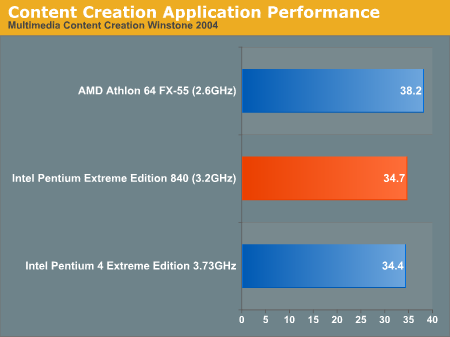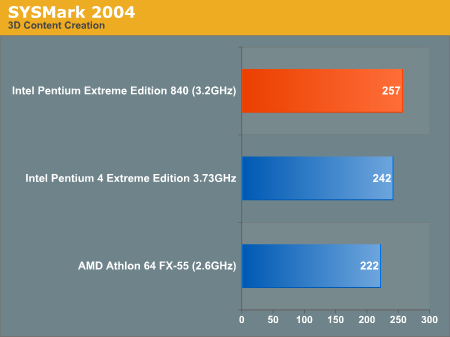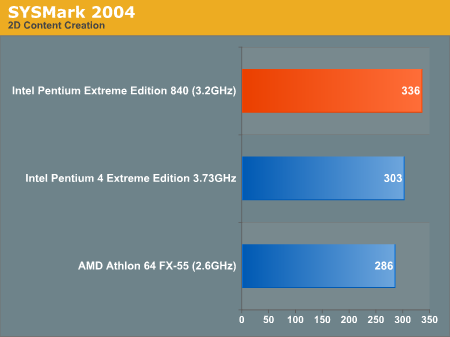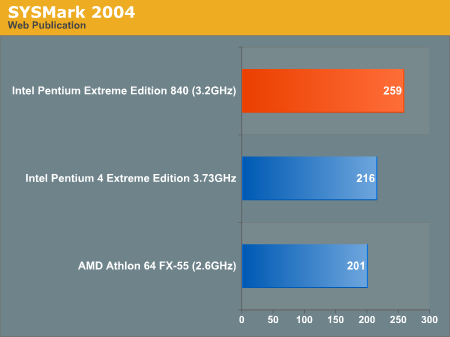Intel Dual Core Performance Preview Part I: First Encounter
by Anand Lal Shimpi on April 4, 2005 2:44 PM EST- Posted in
- CPUs
Multimedia Content Creation Performance
MCC Winstone 2004
Multimedia Content Creation Winstone 2004 tests the following applications in various usage scenarios:
- Adobe® Photoshop® 7.0.1
- Adobe® Premiere® 6.50
- Macromedia® Director MX 9.0
- Macromedia® Dreamweaver MX 6.1
- Microsoft® Windows MediaTM Encoder 9 Version 9.00.00.2980
- NewTek's LightWave® 3D 7.5b
- SteinbergTM WaveLabTM 4.0f
All chips were tested with Lightwave set to spawn 4 threads.

ICC SYSMark 2004
The first category that we will deal with is 3D Content Creation. The tests that make up this benchmark are described below:"The user renders a 3D model to a bitmap using 3ds max 5.1, while preparing web pages in Dreamweaver MX. Then, the user renders a 3D animation in a vector graphics format."

Next, we have 2D Content Creation performance:
"The user uses Premiere 6.5 to create a movie from several raw input movie cuts and sound cuts and starts exporting it. While waiting on this operation, the user imports the rendered image into Photoshop 7.01, modifies it and saves the results. Once the movie is assembled, the user edits it and creates special effects using After Effects 5.5."

The Internet Content Creation suite is rounded up with a Web Publishing performance test:
"The user extracts content from an archive using WinZip 8.1. Meanwhile, he uses Flash MX to open the exported 3D vector graphics file. He modifies it by including other pictures and optimizes it for faster animation. The final movie with the special effects is then compressed using Windows Media Encoder 9 series in a format that can be broadcast over broadband Internet. The web site is given the final touches in Dreamweaver MX and the system is scanned by VirusScan 7.0."

As soon as we throw in more content creation applications, some of which are multithreaded (e.g. 3ds max, Windows Media Encoder 9), the performance advantage of dual core is established. Here, we see that the dual core Pentium Extreme Edition running at 3.2GHz holds a 6% to 20% performance advantage over the higher clocked 3.73EE.
The performance advantages here are nice, but not the sort of order of magnitude in improvement that we'd been hearing about...










141 Comments
View All Comments
Pandaren - Tuesday, April 5, 2005 - link
Drat. Double Post. Where's the gaming benchmarks? And are those multitasking scenarios realistic? I don't think I would ever do all that at once.Pandaren - Tuesday, April 5, 2005 - link
sideshow23bob - Monday, April 4, 2005 - link
Additionally, what about throwing in Nero,DC++, azureus, bitcomet, and/or Power DVD. Just progs. that alot of typical college-aged users use(i can verify at least). Great article. Loved the multitasking analysis especially.sideshow23bob - Monday, April 4, 2005 - link
ravedave - Monday, April 4, 2005 - link
Anand, what about DVDDecrypt and DVDShrink at the same time (as in decrypting one movie, shrinking another)? Dual core could really make ripping faster if you could do both of those at once...ViRGE - Monday, April 4, 2005 - link
#44, SETI is a really good idea, not just because of heat but because it'll push the memory/FSB at the same time. If Intel's chips are getting choked, SETI should scream pretty loudly by tanking in performance.nigham - Monday, April 4, 2005 - link
Thanks, this was a real nice review and its got me all excited. One thing I'd really like to know, though, how does Linux handle dual-core? Does it show the same kind of multi-tasking performance boost that we see on Windows XP? I mostly use Linux for my work and I do a ton of multitasking. Windows I use only for gaming, which as you point out are mostly single threaded applications.gregwjones - Monday, April 4, 2005 - link
Dual-core benchmarks I'd like to see:Two instances of Seti@Home, BOINC version, run on a Pentium D 3.2GHz( dual-core, but no HT )
compared to Pentium 4 3.2GHz single core with HT.
Then run four instances of SETI@Home on the Pentium EE ( dual-core with HT ).
This should generate a lot of heat and put everything at max load.
I have a Pentium 4 Northwood with HT enabled and run two instances of BOINC Seti@Home while using the system to do everyday tasks.Like web browsing, DVD Decrypt, DVD Shrink. Everything is very responsive because BOINC runs at a very low priority.
dragonballgtz - Monday, April 4, 2005 - link
Great article! It's a good thing you did not do a review like all of the other sites. With just some benchmarks and a few games.As always I can't wait to read more reviews form you Anand. :thumbsup;
shabby - Monday, April 4, 2005 - link
The multi-tasking numbers are definetly intresting, but any sane person will wait and see what amd has up its sleeve.